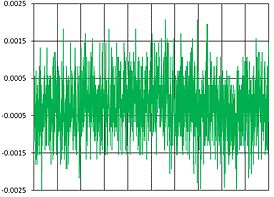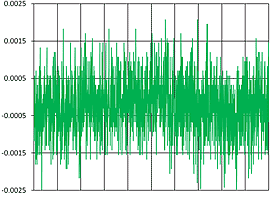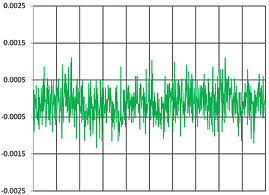TECHNOTE LT05-0010
General Sensor TechNote LT05-0010
This article is also published in Machine Design Magazine.
Copyright © 2014 Lion Precision. www.lionprecision.com
Summary
The TechNote describes in detail the important factors in the interpretation of displacement resolution specifications found in most sensor datasheets – an often misinterpreted number.
Introduction
As a machine designer or engineer, you must continually specify sensors for use in your designs. During your search, you are confronted by an array of product specifications you must rely upon to select the sensor with the right cost-performance ratio. Unfortunately, not all displacement sensor specifications are presented in a way that allows direct comparison. Resolution is one of the most frequently misunderstood and poorly defined descriptions of performance.
Resolution is an important specification because without sufficient resolution you may not be able to reliably make the needed measurement, and an over performing sensor will burden your budget. Resolution is only meaningful within the context of the system bandwidth, the application, and the measurement method and unit of measure used by the sensor manufacturer. A simple “resolution spec” in a datasheet rarely provides enough information for a fully informed sensor selection. Understanding this important specification will empower you to more confidently make the right displacement sensor choice.
Sensor Resolution Is Not About “Bits”
Essentially, resolution is the smallest measurement a sensor can reliably indicate. Before discussing this in any detail, it is important to understand what resolution is not; it is not the least significant digit in a display or the least significant bit in a conversion between the digital and analog worlds. Digital devices have a resolution specification based on the least significant bit, and if insufficient, may further degrade the overall sensor resolution, but the fundamental limit of a sensor’s resolution is determined in the analog world; the battle for higher resolutions in sensor design is primarily a fight against electrical noise.
Resolution is also not accuracy. An inaccurate sensor could have high resolution, and a low resolution sensor may be accurate in some applications.

Figure 1.
Electrical noise in the sensor output voltage
The electrical noise in a sensor’s output is the primary factor limiting its smallest possible measurement. All electronic components produce small random changes in voltage potentials that combine throughout the circuitry and appear as a band of noise when viewed with an oscilloscope (Fig. 1). Electrical noise is a factor in any electronic system trying to sense small changes in voltage. For example, electrical noise causes image graininess in telescopes using CCD detectors. Users can’t see small distant objects if the objects are the same size as the noise-induced grains. Some high-tech telescopes use supercooled CCDs because extremely low temperatures nearly eliminate the random movement of charges in the CCD thereby reducing electrical noise to near zero. With little noise, the small objects are now visible . For you, the engineer specifying a displacement/position sensor, the essential problem is this: your measurement of a 1µm displacement will be lost if the sensor has 10µm of noise in the output. It is critical that the resolution of your selected sensor be considerably lower than the smallest measurement you are trying to achieve, but sensor resolution specifications can be misleading. Bandwidth, unit of measure, and other information must be included in the resolution specification in order to predict the smallest measurement you will be able to make in your specific application.
Sensor Resolution and Bandwidth

Figure 2
Noise of a sensor with 15kHz bandwidth
Bandwidth (frequency response) indicates how sensors respond at different frequencies. Higher bandwidth sensors can measure higher frequency motion and vibration. Electrical noise is generally broadband, which means it contains a wide spectrum of frequencies. A low-pass filter will reduce or eliminate high frequency noise, while reducing the sensor’s bandwidth.Low-pass filtered signals have less noise and therefore better resolution but at the expense of usable bandwidth.Figure 2 shows the noise of a sensor with a 15kHz bandwidth, and Figure 3 shows the same sensor output with a 100Hz low-pass filter. Because of the lower noise level, you would be able to see smaller displacements with the low-pass filtering, but you would not be able to accurately detect displacements occurring at frequencies at 100Hz or higher. This is why a resolution specification apart from a bandwidth specification is not entirely useful. You must know if the resolution specification will hold at the frequency at which you need to make your measurement. Even though a sensor may have a general bandwidth specification of 1kHz or higher, the resolution may have been specified at 100Hz or lower, but the datasheet may not clearly indicate that. Do not assume that a sensor’s general bandwidth specification and resolution specification can be achieved simultaneously.

Figure3
Noise of a sensor with 100Hz bandwidth
Some manufacturers provide two resolution specifications: Static and Dynamic. The Static specification only applies when the sensor output is low-pass filtered for low bandwidth, sometimes as low as 1-10Hz. This is only useful if you will be using the sensor with an equivalent bandwidth filter to measure slow moving systems. The Dynamic specification is usually for an unfiltered sensor; this is the resolution you can expect when using the sensor at full bandwidth in high-speed dynamic applications. If the data sheet uses Static and Dynamic terms, search for a note that defines exactly what frequencies are represented by Static and Dynamic. Until you have actual frequencies, you will not know if the sensor is a good choice for your application. Lion Precision lists resolution at specific bandwidths, removing any guess work.
Where is the Filter for Low Bandwidth Resolution?
Some manufacturers list low bandwidth specifications for their sensors, but the sensors have no integral filter to produce the low bandwidth output. Often, these low bandwidth specifications are theoretical calculations. If you want the low bandwidth preformance, you will have to provide your own filtering.
When sensor resolution is reported for lower bandwidths, it is critical that you know if the device actually has such a filter. If the bandwidth filter is integral to the sensor, you can be confident that you will achieve the specified resolution. If the manufacturer used an external filter to generate the specification or simply calculated a number, you must know all the parameters of the filter, not just the cutoff frequency. Lion Precision sensors include integral bandwidth filters assuring that actual performance will match the specifications.
Sensor Resolution Units of Measure
A resolution specification may be given in volts, percent of full scale, or dimensional units. Perhaps the most meaningful to the engineer trying to measure position/displacement is dimensional units. A dimensional unit specification, such as nanometers, will clearly indicate the smallest displacement measurement you can reliably make with the sensor. If the specification is given as a percent, that value must be multiplied by the sensor’s range to determine the smallest possible displacement measurement. If the specification is given as a voltage, then the value will have to be multiplied by the sensor’s sensitivity (displacement units/voltage change) to determine the smallest possible displacement measurement. Once you know the sensor’s resolution in dimensional units, it is critical that you determine if the specification represents an RMS or Peak-to-Peak value.
The distinction between RMS (root mean square) and Peak-to-Peak (sometimes called by the equivalent name Peak-to-Valley) is critically important to understanding the absolute sensor performance. Analog methods of measuring these values include special meters and visual interpretation of an oscilloscope display. In the digitized world, these values are calculated by capturing a large number of samples of the output voltage and analyzing the data statistically.
RMS measurements of dynamic electrical signals indicate the equivalent power from a DC source. It is similar to, but not the same as, an average value. RMS values may be determined by analog meters which measure the signal power and equating it to a DC voltage that would produce the same power. When digitized and analyzed statistically, the RMS value is equal to the standard deviation of the captured samples. RMS is the most relevant specification when measuring broadband vibration.
Peak-to-Peak (P-P) is the difference between the maximum and minimum peaks of the noise over some period of time. Figure 3 shows a P-P noise level of 2.4mV over one second. If the signal is captured digitally, the samples can be analyzed to find the maximum and minimum peaks. If the samples create a perfectly normal (Gaussian) distribution, the P-P value can be estimated as six times the standard deviation, but in practice, this is rarely the case. Noise signals are rarely so well behaved and usually contain spurious peaks that create an actual P-P value much higher than six times the standard deviation. This means thatresolution values specified by their P-P range must be at least six times greater than RMS values and are usually considerably higher than that. The 2.4mV P-P value in Figure 3 translates to 0.29mV RMS; the P-P value is more than eight times higher than the RMS value in this case.
The P-P value is the most appropriate specification if you are trying to continuously determine the instantaneous position of your target. At any moment in time, the sensor output can vary by an amount equal to the P-P resolution specification; therefore, your position measurement can vary by that same amount.
Reading Datasheets
To fully understand the resolution of the sensor you are considering, you must conclusively identify these parameters in the specification:
• A resolution specification(s)
• Bandwidth at which the stated resolution is obtained
• If any bandwidth filters are integral to the sensor
• Unit and type (P-P or RMS) of measure of the resolution specification
Most sensor datasheets list a resolution specification, but they may not provide all of the information required to fully understand the actual resolution you will have in your application. Resolution may be listed as a single specification that applies to all ranges for a particular model, or there may be separate resolution specifications for each probe/range combination. The datasheet will likely include a bandwidth specification for the sensor, but it may or may not clearly list the bandwidth at which the resolution was specified; the resolution bandwidth may have to be searched for in footnotes or other small print. If the bandwidth is not listed, you will need to verify with the manufacturer that the resolution specification applies at the full bandwidth of the system. If resolution information is available at multiple bandwidths, it may be difficult to determine if the bandwidth filters are integral to the sensor. If the sensor is listed as being available in multiple bandwidth configurations, the filters are likely to be integral and the resolution specification will apply to the sensor you will receive. If no mention is made of the sensor’s capacity to be configured at different bandwidths, you will need to ask the manufacturer how the other bandwidths were achieved when the resolution was specified.
Because RMS resolution specifications are always significantly lower than P-P, most datasheets will list resolution as an RMS value. If you are measuring continuous instantaneous position, you will need to know the P-P resolution. The datasheet may list both RMS and P-P values, or a multiplier for converting the RMS value to P-P. If no P-P value or multiplier is listed, you will have to contact the manufacturer; in the meantime, you can assume that the P-P value is at least six times higher and usually closer to ten times higher.
Is it a guaranteed “specification” or just “typical”?
Read datasheets carefully. Some “specifications” are not guaranteed, and therefore aren’t specifications at all. Instead, these values will be listed as “typical.” This means that system you receive will be within a few standard deviations of the “typical” device; there’s a good chance your resolution will not be as good as the listing in the datasheet.
True “specifications” are guaranteed values. This means the system you receive will likely have slightly better resolution than the specification. Are LIon Precision resolution specifications are guaranteed.
Save Yourself A Headache
As an engineer, you have experienced the pain of discovering mid-process that some component of your system doesn’t perform as you expected. By understanding sensor resolution, its relationship to bandwidth, the different units of measure, and how they are listed in datasheets, you can now make more confident decisions about your displacement sensors.
